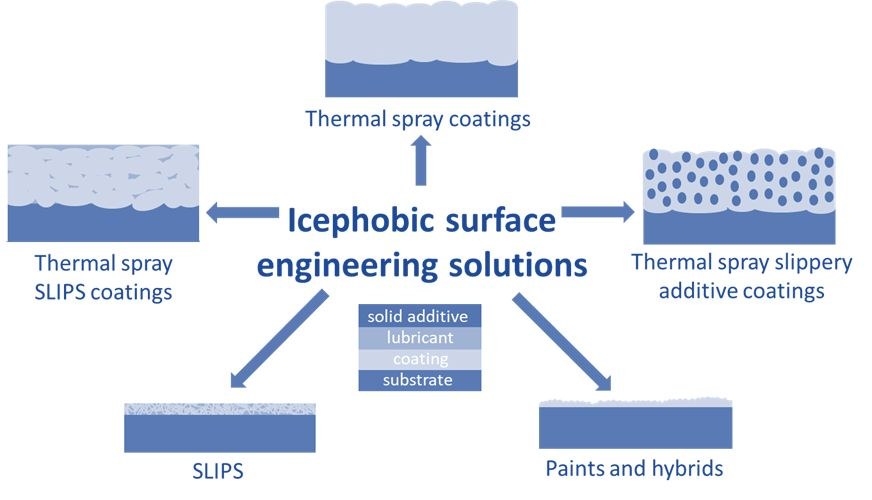Icephobic surface engineering solutions

Icephobicity
Icephobicity can be defined as the surface property, which minimizes ice adhesion between the surface and ice. Lower the ice adhesion, higher the icephobicity. Furthermore, a passive anti-icing procedure means a process that prevents ice formation over a protected surface whereas a de-icing procedure reflects to a removal of accreted ice from a surface by using active methods e.g., mechanical removal, heating or with chemicals. Passive anti-icing solutions are more durable and environmentally friendly options compared to active de-icing methods. For passive anti-icing purposes, low ice adhesion surfaces can be produced by using surface engineering technologies. Picture 1 summaries different icephobic surface engineering solution approaches, which are under research and development at Tampere University Icing Research group.

Surface engineering solutions
Several coatings and surface modifications can be considered as potential icephobic surface engineering solutions. In the optimal situation, icephobic surface reduces interactions between the surface and incoming water in the atmospheric cold conditions as well as lowers ice adhesion between the surface and accreted ice.
Generally, icephobic surface engineering solutions need specific surface topography, surface chemistry and wetting behaviour. In addition to icing performance, other application-related requirements need to be taken into account while designing durable icephobic surfaces for outdoor conditions.
At Tampere University, icephobic coatings with functional properties have been developed and several surface engineering approaches offer solutions. Thermal spraying has shown its potential to produce industrial scale coatings with various properties. Thermally sprayed polymer (see photo), composite, and SLIPS coatings have shown low, and medium-low ice adhesions, indicating their potential [1-4].
Summary
Many industrial fields are facing icing problems (Picture 2). When ice accretes on the surface, it causes delays in operation, increases costs and causes safety issues. Surface engineering can offer different solutions to increase icephobicity of the surfaces and this way, improve components’ performance in cold climate conditions. Suitable coating or surface modification needs to be selected based on application-related requirements e.g., icing, and mechanical properties as well as other environmental stresses.

References
- V. Donadei, H. Koivuluoto et al., Durability of Lubricated Icephobic Coatings under Various Environmental Stresses, Polymers, 14,2, 2022
- H. Koivuluoto et al., Thermally sprayed coatings: Novel surface engineering strategy towards icephobic solutions, Materials, 13,6, 2020, 1434
- H. Niemelä-Anttonen, H. Koivuluoto et al., Thermally Sprayed Slippery and Icephobic Surfaces, ITSC2018, 7-10 May 2018, Orlando, USA, 380-384
- H. Koivuluoto et al., Anti-Icing Behavior of Thermally Sprayed Polymer Coatings, Journal of Thermal Spray Technology, 26,1-2, 2017, 150-160
Text and pictures: Heli Koivuluoto
Photo: Jonne Renvall






